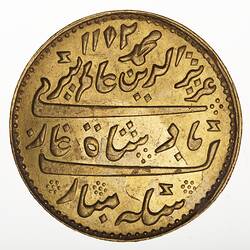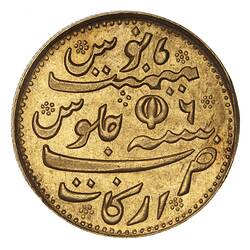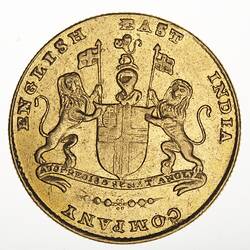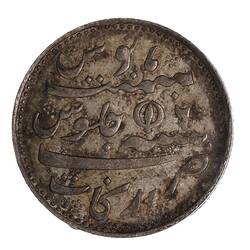Summary
1 Gold Rupee, Issued by, East India Company, Madras Presidency, India, 1172 AH Regnal year 6
Second European Style (1817-1818)
Minted by Madras Mint
Obverse Description
Legend in Persian script (translation: 1172 the auspicious coin of the Victorious Emperor Chosen of the faith of Muhammad, Alamgir) Note: the legend and date are of a frozen type, they do not name the issuer nor give the date of production
Reverse Description
Legend in Persian script (translation: Struck at the Arcot Mint in the 7th year of his tranquil prosperity) with the closed lotus mark Note: the legend and mint name are of a frozen type, they do not name the mint nor give the year of production.
Edge Description
centre milling \\\
Significance
The East India Company obtained permission to strike Arkat style rupees from the Subah of Arkat (Arcot) in 1742. The first actual production under this was in 1759 in the name of Alamgir II and bear the Hegira date 1172 with the regnal year 6. This machine struck gold rupee although produced in the period 1817 to 1818 AD retains the original date. The coin also refers to the Arkat mint although struck at the Company's mint in Madras. The gold rupee (also known as a Muhr or Mohur) was proclaimed on 9 December 1817 and was valued as 15 silver rupees. These coins were replaced in 1819 by a mohur or ashrafi of the same standard and weight as this, but bearing the Company arms, in 1819 because the use of the same designs on silver and gold coins of about the same size had led to the silver pieces being gilded and passed as gold.
More Information
-
Collecting Areas
-
Acquisition Information
Transfer from National Gallery of Victoria (NGV), A.H. Baldwin & Son Ltd, 15 Mar 1976
-
Date Issued
1817 AD
-
Issued By
-
Mint
-
Denomination
-
Series
-
Material
Gold
-
Axis
12
-
Classification
-
Category
-
Discipline
-
Type of item
-
Dimensions
28 mm (Outside Diameter), 11.66 g (Weight)
-
Shape
Round
-
References
Pridmore 238 KM#418
[Book] Pridmore, Fred. 1975. The Coins of the British Commonwealth of Nations, Part 4, India. 1., 38 & 78 Pages
[Book] Bruce, Colin R. 2006. Standard Catalogue of World Coins 1801 - 1900., 703 Pages
-
Keywords
British Commonwealth Coins, British Commonwealth and Empire Coins




